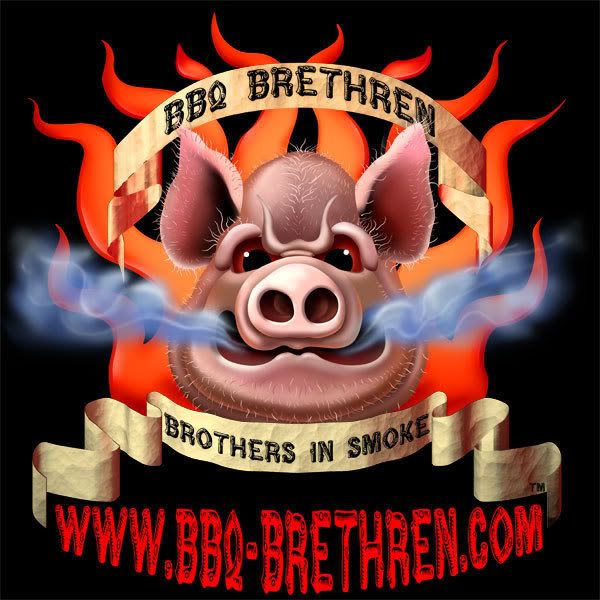Let's talk about barbecue. This is a blog about barbeque isn't it? No more soup recipes for awhile, I promise.
Let's spend some time talking about a common ingredient that is found in many
BBQ sauces across the county --
Molasses. Do you know the difference between types of molasses? We often hear the term "blackstrap molasses," but what does that mean? "Dark", "Light", "
Barbados Molasses"; what is it and which do I use? What does molasses taste like?
Here's some answers. Our friends at
Hormel Foods provides us with this great guide to molasses. Enjoy.
MolassesA thick, strong flavored syrup, produced as a by-product when sugar is refined through several boilings of sugar cane or sugar beets. Molasses is the brown heavy syrupy liquid that remains after the sugar cane or beets have been boiled into a juice and then the sugar crystals are removed. There are basically 3 types of Molasses produced from the refining and boiling process: light, dark and blackstrap Molasses. Some food manufacturers will produce variations of the 3 different types, which are generally lighter in texture and color but sweeter in taste.
Light Molasses are produced from the first boiling. The lighter Molasses, often referred to as "original," "mild" or "Barbados" Molasses, provide a subtle, sweet tasting syrup. It is an ingredient that is commonly added to syrups, baked goods, marinades, rubs, and sauces, or served as a topping for toast and biscuits. It is combined with foods and recipes which benefit from the addition of a mildly sweet product that is more mellow in flavor. This variety produces cookies that may be somewhat softer and breads that are more crusty.
The second boiling produces a darker Molasses, also known as "robust," "full flavored" or "cooking Molasses", that is not as sweet as light Molasses but thicker in texture. The dark Molasses are most often used to flavor sweets, such as fruit cake, ginger snaps, gingerbread, shoefly pie, and Indian pudding. It is also used to flavor baked beans and sauces such as barbecue, meat, soy, spaghetti, or sweet and sour sauce. Light and dark Molasses can generally be used interchangeably.
The third boiling produces the blackstrap Molasses, a very dark and thick solution with a somewhat bitter flavor. This variety of Molasses can be found in natural food stores where it is sold for its nutritional benefits, which have not been fully proven yet. The majority of blackstrap Molasses ultimately become an ingredient for use in the production of livestock feed. However, it is often used as a coloring agent in foods as well as a sweetener for some baked goods, meat and vegetable dishes when blended with light Molasses. Similarly produced is a sugar known as treacle, a Molasses product that is common in Eurpoean areas such as the United Kingdom and like Molasses, is produced as a byproduct or residue of cane refining. It is available as light or dark treacle both of which have the same characteristics as light and dark Molasses.
When a Molasses container identifies the product as "sulphured" or "unsulfured" the terms are used merely to advise which Molasses were refined using sulphur dioxide. Sulfured Molasses are made from young sugar cane, which requires sulfur dioxide during the sugar refining process. As the sulfur becomes mixed into the Molasses solution, a change in flavor occurs, reducing some of rich taste generally provided by Molasses not processed with sulfur dioxide. Unsulfured Molasses are made with more mature raw materials and the juice is clarified as it is processed, producing a higher quality, thicker, sweeter, and better tasting grade of Molasses. Unsulfered Molasses are typically preferred for recipes in order to provide a more pure flavor.
Other types of Molasses are also produced, such as pomegranate Molasses from the sugars in pomegranate juice; sorgum Molasses made from sorgum grain and processed into a syrup; and bead molasses, a Molasses similar to light Molasses, which is commonly used as a flavoring and coloring for many Asian food dishes.
All Molasses should be stored in dry, moderately temperate (50°F to 70°F) areas, away from heat and humidity. Light and dark Molasses can be kept for 1 to 2 years, while blackstrap Molasses stored at room temperature should only be kept for 3 months or less.

Light, Dark, Black Strap and Bead Molasses (I can't really see a difference in the pictures. I guess you have to be there.)
Preparation Tips
To remove molasses more easily from a measuring cup or spoon, coat the inside of the measuring utensil with vegetable oil, which can also occur if a recipe requires the use of oil. Measure the oil first and then leave the measuring utensil coated with the oil and measure the molasses.
To reduce the acidity of molasses when making baked foods, add baking soda to the recipe with a ratio of 1 teaspooon for each cup of molasses.


 Equipment
Equipment







 The Kansas City Barbeque Society
The Kansas City Barbeque Society The New England BBQ Society
The New England BBQ Society The Mid Atlantic BBQ Association
The Mid Atlantic BBQ Association The Hampton Smoker
The Hampton Smoker Your guide to BBQ joints in Boston, New York and everywhere in between
Your guide to BBQ joints in Boston, New York and everywhere in between
 The Pickled Pig Forums
The Pickled Pig Forums BBQ-4-U Forums
BBQ-4-U Forums  National BBQ News Forums
National BBQ News Forums  The Virtual Weber Bullet
The Virtual Weber Bullet HomeBBQ.com
HomeBBQ.com Edible Brooklyn
Edible Brooklyn  BBQTV.com The source for BBQ competition coverage, cooking tips, sauces, rubs, grills, equipment and anything to do with barbecue.
BBQTV.com The source for BBQ competition coverage, cooking tips, sauces, rubs, grills, equipment and anything to do with barbecue.  The BBQ Guy's Blog
The BBQ Guy's Blog  The BBQ Report
The BBQ Report 
















